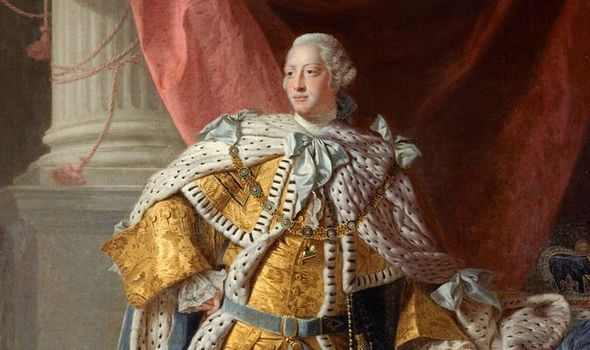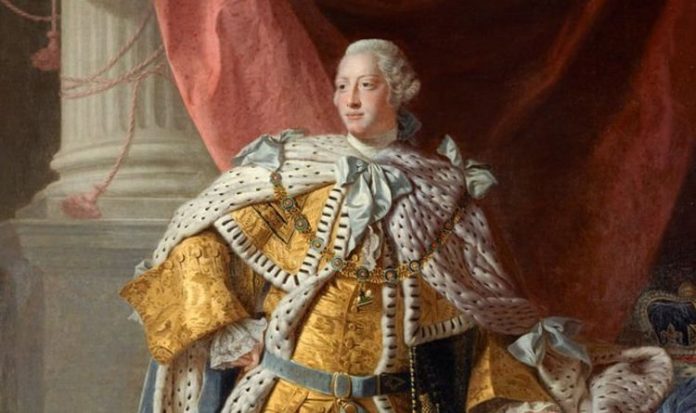Prince Charles identifies with ‘mad’ King George III says expert
George III is famous for being the “mad king who lost America” and his erratic behaviour is well-documented. The Crown season four, released this month, has raised awareness of the Royal Family and its rocky relationship with mental health. In episode seven, Princess Margaret, played by Helena Bonham Carter, discovers that two cousins on her mother’s side were sent to a hospital for people with mental disabilities, where they had no contact with the family and were even declared dead.
The Queen Mother, played by Marion Bailey explains that they did this because there were fears people would “question the integrity of the bloodline” if they knew there was a genetic condition in their family that affected mental faculties.
She says: “The idea that one family alone has the automatic birthright to the Crown is already so hard to justify.
“The gene pool of that family, it better have 100 percent purity.
“There have been enough examples on the Windsor side alone for people to worry about: King George III… Prince John, your uncle.
READ MORE: Queen’s uncle Prince John’s illness ‘hidden from public’

King George III famously suffered from mental instability (Image: GETTY)

Helena Bonham Carter as Princess Margaret in The Crown (Image: Netflix)
“You add the Bowes-Lyon illness to that, the danger is it becomes untenable.”
There have been numerous other references to George III’s supposed “madness”, including the long-running play by Alan Bennett, The Madness of George III, which was later adapted for film starring Nigel Hawthorne in the title role.
This play and film featured a key theory as to what caused George III’s behaviour: that he suffered from a physical, genetic blood disorder called porphyria.
Its symptoms included aches and pains, as well as the bizarre symptom of blue urine.

Nigel Hawthorne in The Madness of King George (Image: GETTY)
However, a research project based at St George’s, University of London appears to have debunked this after finding another reason for the unusual symptom.
George III’s medical records show that the King was being given medicine based on gentian.
The plant, with its deep blue flowers, is still used today as a mild tonic, but one of the possible side effects is that it can turn urine blue.
Indeed, it seems it may not have been his condition that caused this symptom, but actually his medicine, historian Lucy Worsley explained to the BBC.
DON’T MISS
Princess Diana ‘turned down interview with Sir David Frost’ [REVEALED]
Meghan Markle’s life eerily mirrored her ex-husband Trevor Engelson’s [INSIGHT]
Princess Diana was ‘traumatised’ by humiliating Prince Charles comment [QUOTE]

Nigel Hawthorne in The Madness of King George (Image: GETTY)
The research group concluded that George III actually did suffer from mental illness, most likely bipolar disorder.
This is based on thousands of handwritten letters written by the King that have been analysed by Dr Peter Garrard and Dr Vassiliki Rentoumi.
The academics looked at George’s use of language and discovered that during his episodes of illness, his sentences were much longer than when he was well.
A sentence containing 400 words and eight berns was not unusual.
George III’s papers in ‘groundbreaking’ public display
What’s more, when the King was ill he often repeated himself and his vocabulary became more complex, creative and colourful.
All these features can be seen today in the writings and speech of patients experiencing the manic phase of illnesses such as bipolar.
People suffering from bipolar disorder experience periods of mania – or harmful euphoria, where they feel very high and overactive – followed by periods of depression, on the other end of the spectrum of mood, where they feel very low and lethargic.
George III experiencing mania would also match contemporary descriptions of his behaviour.
For example, observers spoke of his “incessant loquacity” and his habit of talking until the foam ran out of his mouth.
Sometimes he suffered from convulsions and his pages had to sit on him to keep him safe on the floor.
George III’s recurring bouts of illness caused him to withdraw from daily business to recuperate out of the public eye at Kew Palace.
Later in life, it is believed he developed dementia too, and eventually in 1810, a regency was established.







